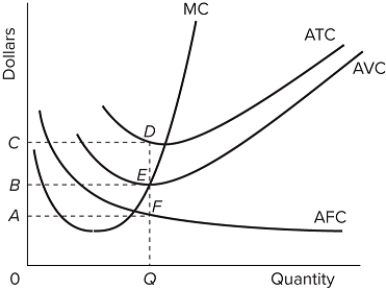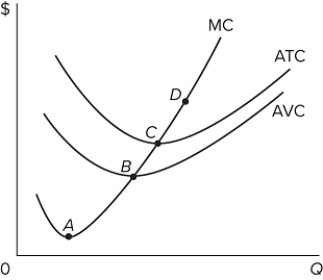A) $286,000.
B) $150,000.
C) $94,000.
D) $156,000.
F) A) and B)
Correct Answer

verified
Correct Answer
verified
True/False
The law of diminishing returns explains diseconomies of scale.
B) False
Correct Answer

verified
Correct Answer
verified
Multiple Choice
The vertical distance between the total cost and the total variable cost curves differs by an amount that
A) initially increases, but then decreases, as output increases.
B) is constant as output changes.
C) decreases as output increases.
D) increases as output increases.
F) A) and D)
Correct Answer

verified
Correct Answer
verified
True/False
Diseconomies of scale are caused by the law of diminishing marginal returns.
B) False
Correct Answer

verified
Correct Answer
verified
Multiple Choice
The basic characteristic of the short run is that
A) barriers to entry prevent new firms from entering the industry.
B) the firm does not have sufficient time to change the size of its plant.
C) the firm does not have sufficient time to cut its rate of output to zero.
D) a firm does not have sufficient time to change the amounts of any of the resources it employs.
F) A) and D)
Correct Answer

verified
Correct Answer
verified
Multiple Choice
Round Things, Inc.'s production process exhibits economies of scale. Currently their long-run average cost is $12/unit. If Round Things doubles its use of all inputs, its new long-run average total cost will be
A) $12/unit.
B) less than $12/unit.
C) greater than $24/unit.
D) greater than $12/unit but less than $24/unit.
F) B) and C)
Correct Answer

verified
Correct Answer
verified
Multiple Choice
Assume that in the short run a firm is producing 200 units of output, has average total costs of $250, and has average variable costs of $150. The firm's total variable costs are.
A) $30,000.
B) $50,000.
C) $100.
D) $20,000.
F) C) and D)
Correct Answer

verified
Correct Answer
verified
Multiple Choice
Round Things, Inc.'s production process exhibits economies of scale. Currently their long-run average cost is $12/unit. If Round Things doubles its use of all inputs, its new long-run average total cost will be
A) $12/unit.
B) less than $12/unit.
C) greater than $24/unit.
D) greater than $12/unit but less than $24/unit.
F) A) and B)
Correct Answer

verified
Correct Answer
verified
Multiple Choice
The amount of calendar time associated with the long run
A) is less than that associated with the immediate market period.
B) varies from industry to industry.
C) is the same for all firms.
D) is, by definition, any length of time greater than one year.
F) All of the above
Correct Answer

verified
Correct Answer
verified
Multiple Choice
In comparing the changes in TVC and TC associated with an additional unit of output, we find that
A) no generalization about the changes in TC and TVC can be made.
B) the changes in TC and TVC are equal.
C) the change in TC is greater than the change in TVC.
D) the change in TVC is greater than the change in TC.
F) B) and D)
Correct Answer

verified
Correct Answer
verified
True/False
Economic profits are usually larger than accounting profits.
B) False
Correct Answer

verified
Correct Answer
verified
Multiple Choice
 Refer to the diagram. At output level Q,
Refer to the diagram. At output level Q,
A) marginal product is falling.
B) marginal product is rising.
C) marginal product is negative.
D) one cannot determine whether marginal product is falling or rising.
F) B) and C)
Correct Answer

verified
Correct Answer
verified
Multiple Choice
When a firm does more of something, it gets better at it. This learning-by-doing is
A) a source of diseconomies of scale.
B) a source of economies of scale.
C) called the principle of natural progression.
D) called "spreading the overhead."
F) C) and D)
Correct Answer

verified
Correct Answer
verified
Multiple Choice
 Refer to the diagram. At output level Q, total cost is
Refer to the diagram. At output level Q, total cost is
A) 0 BEQ.
B) BCDE.
C) 0 BEQ + BCDE.
D) 0 AFQ + BCDE.
F) C) and D)
Correct Answer

verified
Correct Answer
verified
Multiple Choice
If a more efficient technology was discovered by a firm, there would be
A) an upward shift in the AVC curve.
B) an upward shift in the AFC curve.
C) a downward shift in the AFC curve.
D) a downward shift in the MC curve.
F) None of the above
Correct Answer

verified
Correct Answer
verified
Multiple Choice
A fast-food company spends millions of dollars to develop and promote a new hamburger on their menu only to find that consumers won't buy it because they don't like the taste. From an economic perspective, the company should
A) keep the hamburger on the menu because they've spent so much money and time developing and promoting the product.
B) spend more money to develop a more efficient way to cook the hamburger so it cooks in a shorter time.
C) pull the hamburger off the menu and treat the development and promotion expenditures as a sunk cost.
D) keep trying to sell the hamburger so that people who developed and promote it have a job with the company.
F) B) and C)
Correct Answer

verified
Correct Answer
verified
Multiple Choice
 Refer to the provided table. When output increases from 28 to 35 units, the marginal cost of the product is
Refer to the provided table. When output increases from 28 to 35 units, the marginal cost of the product is
A) $4.44.
B) $5.71.
C) $6.00.
D) $6.67.
F) None of the above
Correct Answer

verified
Correct Answer
verified
Multiple Choice
 Refer to the provided graph. At which point is marginal product (MP) at its maximum?
Refer to the provided graph. At which point is marginal product (MP) at its maximum?
A) point A
B) point B
C) point C
D) point D
F) B) and C)
Correct Answer

verified
Correct Answer
verified
Multiple Choice
The following is cost information for the Creamy Crisp Donut Company.Entrepreneur's potential earnings as a salaried worker = $50,000Annual lease on building = $22,000Annual revenue from operations = $380,000Payments to workers = $120,000Utilities (electricity, water, disposal) costs = $8,000Value of entrepreneur's talent in the next best entrepreneurial activity = $80,000Entrepreneur's forgone interest on personal funds used to finance the business = $6,000Creamy Crisp Donut Company
A) has lower explicit costs, than implicit costs.
B) is earning a normal profit but not an economic profit.
C) is earning an economic profit.
D) is suffering an economic loss, when implicit costs are considered.
F) All of the above
Correct Answer

verified
Correct Answer
verified
Multiple Choice
Harvey quit his job at State University, where he earned $45,000 a year. He figures his entrepreneurial talent or forgone entrepreneurial income to be $5,000 a year. To start the business, he cashed in $100,000 in bonds that earned 10 percent interest annually to buy a software company, Extreme Gaming. In the first year, the firm sold 11,000 units of software at $75 for each unit. Of the $75 per unit, $55 goes for the costs of production, packaging, marketing, employee wages and benefits, and rent on a building.The explicit costs of Harvey's firm in the first year were
A) $220,000.
B) $605,000.
C) $105,000.
D) $825,000.
F) All of the above
Correct Answer

verified
Correct Answer
verified
Showing 241 - 260 of 445
Related Exams